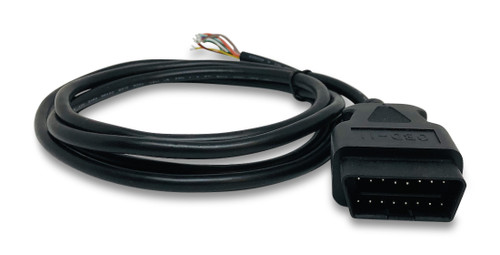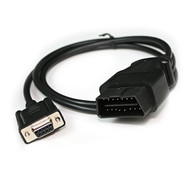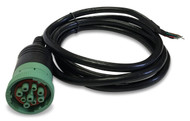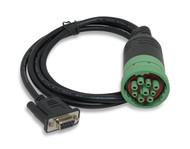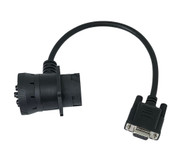- Home
- OBD-II & J1939 Cables
- OBD2 (J1962) 16Pin Cable Open End
Product Description
Free Shipping Within the United States!
This adapter cable is compatible with all OBD II compliant vehicles. All 1996 and newer vehicles (cars and light trucks) sold in the United States must be OBD II compliant and this includes all domestic, Asian and European vehicles.
A few of 1994 and 1995 model year gasoline vehicles are OBD II compliant. Please check the Vehicle Emissions Control Information (VECI) Label which is located under the hood or by the radiator of most vehicles. If the vehicle is OBD II compliant, the label will designate "OBD II Certified". Additionally, Government regulations mandate that all OBD II compliant vehicles must have a 16-pin Data Link Connector (DLC).
If your vehicle is OBD II compliant, it must have a 16-pin DLC under the dashboard, and the Vehicle Emission Control Information Label located on the inside of the hood on most vehicles must state that the vehicle is OBD II compliant.
Features
- RoHS Compliant
- All 16 pins connected
- Length: 6ft.
- AWG 26
- The open end is perfect for custom cable designs and prototyping
- High-quality materials and quality craftsmanship give the cable superior flexibility and durability
- Aluminum foil shielding and twisted pairs for signal lines (J1850 BUS+/BUS- and CAN High/Low lines) give the cable exceptional EMI noise immunity
- The SAE J1962M connector, engineered from the ground up, ensures compatibility with the widest range of vehicles
Pin Assignment
| OBD II 16 Pin Connector | Color | |
| Battery Power | 16 | Green & White |
| Chassis Ground | 4 | Orange |
| Signal Ground | 5 | Yellow |
| CAN High J-2284 | 6 | Green |
| CAN Low J-2284 | 14 | Brown & White |
| ISO 9141-2 K Line | 7 | Blue |
| ISO 9141-2 L Line | 15 | Red & White |
| J2850 BUS- | 10 | White |
|
J2850 BUS+ N/A N/A N/A N/A N/A N/A N/A |
2 1 3 8 9 11 12 13 |
Brown Black Red Purple Grey Pink Light Green Black & White |
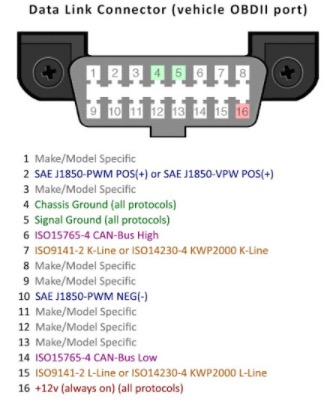
The cable is also directly compatible with our PiCAN2 DUO and PiCAN2 DUO with SMPS (Switch Mode Power Supply), the Dual CAN Bus interface boards for the Raspberry Pi. However, before using the cable with the SMPS version, please assure that the J1939 Battery voltage does not exceed 12 VDC. Otherwise, you may destroy the board.
About ODB2
The OBD-II standard specifies the type of diagnostic connector and its pinout, the electrical signalling protocols available, and the messaging format. It also provides a candidate list of vehicle parameters to monitor along with how to encode the data for each. There is a pin in the connector that provides power for the scan tool from the vehicle battery, which eliminates the need to connect a scan tool to a power source separately. However, some technicians might still connect the scan tool to an auxiliary power source to protect data in the unusual event that a vehicle experiences a loss of electrical power due to a malfunction. Finally, the OBD-II standard provides an extensible list of DTCs. As a result of this standardization, a single device can query the on-board computer(s) in any vehicle. This OBD-II came in two models OBD-IIA and OBD-IIB. OBD-II standardization was prompted by emissions requirements, and though only emission-related codes and data are required to be transmitted through it, most manufacturers have made the OBD-II Data Link Connector the only one in the vehicle through which all systems are diagnosed and programmed. OBD-II Diagnostic Trouble Codes are 4-digit, preceded by a letter: P for engine and transmission (powertrain), B for body, C for chassis, and U for network.
Automotive Diagnostic Systems: Understanding OBD-I & OBD-II
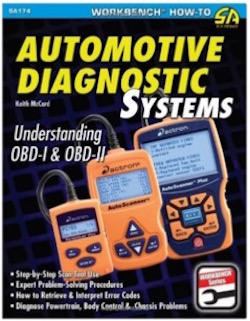 For more than 30 years, cars and trucks have carried onboard diagnostics (OBD), which monitor and adjust major systems, including engine, drivetrain, fuel, and more. Many think that repairing or tuning the current system (OBD- II) is a black art or a computer science, and that there is no way to diagnose and fix computer control-system problems at home with affordable tools. But, that is simply not true.
For more than 30 years, cars and trucks have carried onboard diagnostics (OBD), which monitor and adjust major systems, including engine, drivetrain, fuel, and more. Many think that repairing or tuning the current system (OBD- II) is a black art or a computer science, and that there is no way to diagnose and fix computer control-system problems at home with affordable tools. But, that is simply not true.
OBD expert, tuner, and author Keith McCord explains system architecture, function, and operation. He shows you how to use a hand-held scanner, connect it to the port connector in the car, and interpret the data. But most importantly, he shows you a practical, analytical, and methodical process for tackling a problem, so you can quickly trace its actual source and fix the root cause and not just the symptom. Automotive Diagnostic Systems includes definitions of diagnostic trouble codes and a table of common DTCs.
McCord reveals the intricacies of diagnosing the system, the importance of fixing component DTCs first, one- and two-trip codes, how the PCM erases DTCs, and how you can have DTCs stored in memory with no MIL on, among many other common issues. As a result, you learn how to resolve a range of common OBD-II problems, such as engine misfires, shorts and opens, out-of-tune fuel trims, dead catalysts, emissions leaks, low voltages, failed oxygen sensors, and much more. But it also covers fuel injectors, ignition systems, chassis sensors, and various other sensors and actuators.
 Loading... Please wait...
Loading... Please wait...

